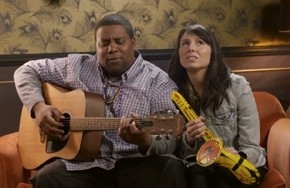About halfway through his short story ”In Persuasion Nation” (which details in American Magical Realist terms the abject commercialism of every aspect of modern life), the great George Saunders has a character ask whether there might be “an approach in which the sacred things in life are no longer appropriated in selling what are, after all, merely-”
At which point the character is cut off. Literally.
(You have to read it.)
So it is with American Marketing Realism. Every mainstream media platform – from newspapers to magazines to television programming – is being appropriated in selling what are, after all, merely – a bag of shells.
Or should that be bag of sells?
Start with the lend/lease of NBC’s landmark Saturday Night Live to marketers.
From MediaPost:
Honda Joins Cast Of NBC Universal’s ‘Saturday Night Line’
NBCUniversal, through its Client Solutions Group and its Content Innovation Agency (CIA), has serious game when it comes to rolling out partnership vehicles for advertisers looking to get behind original branded content. For Honda and its automotive vehicles, that digital content is a new program tied to perpetually-hip “Saturday Night Live.
The automaker is integrated in NBCU’s new “Saturday Night Line” digital platform, a serial on NBC.com and video-on-demand channels like Hulu. The program, with which Honda is promoting its 2015 CR-V SUV and brand new 2016 HR-V crossover, takes viewers to the sidewalks outside Rockefeller Center, where fans of the show wait in line — sometimes for days — for a chance for tickets to an SNL taping. The digital series, starring Upright Citizens Brigade’s Michael Antonucci as host, engages those SNL fans in games, conversations, and surprises, all of which involve Honda and its vehicles in some way. It also involves the SNL cast.
Of course it does.
You can view Saturday Night Lines here. Representative sample:
Don’t expect SNL to send up S(ell)NL anytime soon.
Magazine Publishing Gets Condé Nasty
As the hardtracking staff noted last month, the magazine industry has been in semi-high dudgeon over Condé Nast’s pimping out its editors to native advertisers.
[T]he American Society of Magazine Editors is rethinking its guidelines on native advertising now that Condé Nast and other major publishing houses have publicly confirmed that editors will be writing ad content for their brands.
According to those ASME guidelines, “Editorial contributors should not participate in the creation of advertising if their work would appear to be an endorsement by the magazine of the advertised product.” In theory, all sorts of dire consequences – such as, gasp!, loss of eligibility for National Magazine Awards – could ensue.
Except they won’t, according to Michael Sebastian’s piece in Advertising Age:
Magazine Trade Group Overhauls Advertising Guidelines
Now OK for Editors to Make Ads
The American Society of Magazine Editors has overhauled its guidelines, clearing away hurdles that sought to prevent editors from creating advertising content or publishers from selling ads on magazine covers.
Unlike the old guidelines, where discouraging cover ads was the first item on the list, now there’s no specific language dissuading publishers from selling cover ads. And when it comes to editors collaborating alongside advertisers, the new principles simply say, “Editors should avoid working with and reporting on the same marketer.” They previously said, “Don’t Ask Editors to Write Ads.”
So – that’s sorted, yeah?
And in case you’re wondering, ASME CEO Sid Holt says, “There was no pressure from the business side.”
(Raise your hand if you believe that. Us neither. For a better sense of what’s going on, check out Gawker’s reporting on the current shen-ad-igans at BuzzFeed.)
Ultimately, Holts says, the rules “boil down to one overarching theme, the same as the old guidelines: Don’t deceive the reader.”
Except native advertising is all about deceiving the reader as it mirrors the editorial content around it.
Not to get technical about it.
And, as AdAge notes, “publishers have flouted many of ASME’s guidelines for at least the last year. Time, Sports Illustrated and Forbes have sold cover ads. Conde Nast and Hearst have enlisted some of their editors to make content for advertisers.”
So . . . whatever.
Regardless:
Around the topic of native advertising — in which ads seek to mimic editorial content — ASME does offer some specifics beyond “don’t deceive the reader.”
“On websites populated by multiple sources of content, including user-generated content, aggregated content and marketer-provided content, editors and publishers must take special care to distinguish between editorial content and advertising,” the rules state. “Advertisements that mimic the ‘look and feel’ of the print or digital publication in which they appear may deceive readers and should be avoided.”
So, to recap: Native advertising is okay with ASME. Except it isn’t.
We haven’t seen a manifesto that muddled since the Unabomber’s.
Stop the Press! Newspapers Go Full Native
Birds do it. Bees do it. Even NYT do it.
Let’s do it. Let’s fall in line.
And etc.
The Wall Street Journal has already fallen. Now comes the Washington Post with a new idea.
From Digiday:
The Washington Post takes an Amazon-inspired approach to native ad targeting
Advertisers may complain that it’s hard to scale native ads, but they also want them to be put in front of the right people. Efficiency can mean more than one thing.
The Washington Post believes it has found the solution in its own newsroom, of all places. The newspaper’s data wonks built a tool called Clavis (“key” in Latin) that recommends articles to readers based on an analysis of keywords and phrases in their reading history. Clavis was inspired by the product-recommendation engine used by Amazon (whose founder Jeff Bezos bought the Post in 2013), and it powers “The Post Recommends” widget that appear at the bottom of article pages.
And so, BrandConnect Intelligence was born: “Now, with native, the Post is combining readers’ browsing history with third-party data to build audience segments based on readers’ areas of interest. The product, called BrandConnect Intelligence, then matches native ads with people who are likely to be interested in that topic, regardless of what section of the site they’re visiting.”
As night follows day, here comes the Boston Globe (via Romenesko):
BOSTON GLOBE CEO: ‘SPONSORED CONTENT WILL PLAY A VERY IMPORTANT PART OF OUR GROWTH’
Andrew Gully, who worked at the Boston Herald for 21 years before going into PR, has been named Boston Globe’s content marketing director.
“Sponsored content will play a very important part of our growth,” writes Globe CEO Mike Sheehan, “and it was important to me to find a leader who knows how to tell a great story, understands the inner workings of marketing departments, and has the high standards, metabolism, and curiosity of a journalist.”
Got it? Marketing departments . . . metabolism . . . journalist . . .
You’d have to be an oxymoron to swallow that.
And Mark Duffy at Copyranter isn’t.
Native advertising on editorial websites doesn’t work
Native advertising doesn’t sell for brands. It does little for consumers looking to make a product choice. And it continues to compromise editorial content . . .
What nobody, including BuzzFeed, has been able to prove yet is whether native advertising sells one bit of product.
Maybe not. But it does sell lots of souls.





















